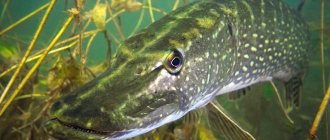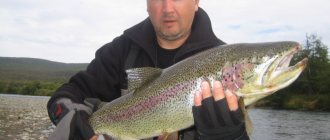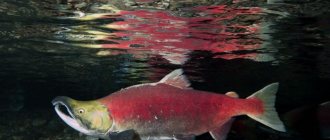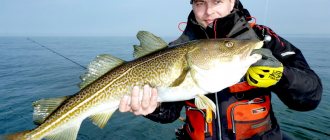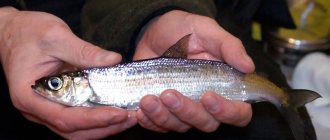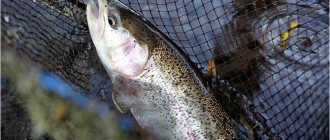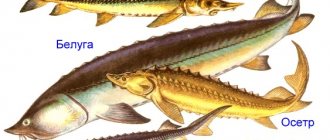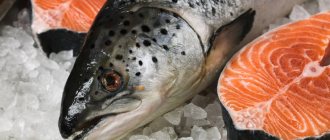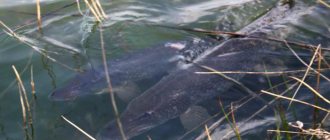When does pink salmon spawn and its habitat?
Among all representatives of the salmon family, pink salmon are the least likely to be close to their place of birth, which is why their habitat is wide. Basically, the natural habitat of these representatives of aquatic fauna consists of the coastal zone of the Pacific, and occasionally reaches the waters of the Arctic Ocean.
In Russia, pink salmon are more often found in Primorye, and during spawning - in the Lena River, Sakhalin and Kamchatka. Before this fish begins to spawn, it is forced to cover a long distance.
Important! Fishing during spawning is strictly prohibited. In this case, fishing can begin immediately after the end of this process, when it goes along the rivers back to the sea.
This is explained by the fact that pink salmon constantly lives in the salty waters of the sea, and selects freshwater reservoirs for spawning. Having reached adulthood, salmon swim north in the spring in search of places where rivers flow into the ocean. In May, the process of spawning begins, which ends only at the beginning of autumn.
In the middle lane
There are no pink salmon in the central zone of the Russian Federation. Despite the fact that in Russia you can find 5 representatives of the salmon family, none of them lives outside of Primorye and eastern Siberia. This is due to the fact that they prefer to live in coastal areas of the ocean. During spawning, pink salmon searches for fresh water, but does not go far into the mainland.
In Kamchatka
There is no season on the Kamchatka Peninsula during which fishing for any member of the salmon family would be unsuccessful . Their numbers peak in late spring and summer, when the active spawning phase occurs. Most pink salmon are found in the Kamchatka River during this period. From the Pacific Ocean, red fish from all coastal areas of the peninsula flow into this freshwater body of water.
Did you know? On the Lena River, where pink salmon go to spawn, there is one of the main natural attractions of the Far East - the Lena Pillars. This geological formation is similar in appearance to the Wall from the series “Game of Thrones”, which is why fans of the film often visit the Yakut miracle.
In the Far East
The Far Eastern District is advantageously located near the Sea of Okhotsk and the Sea of Japan, into which several large freshwater rivers flow. It is to these reservoirs that salmon go from the ocean during spawning. The largest number of fish in the Amur River occurs at the end of June and throughout July.
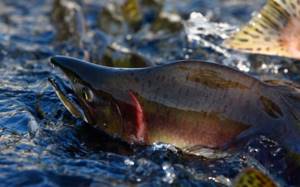
On Sakhalin
The largest island of the Russian Federation, red fish visits the same time as the Far East - in mid-summer. The spawning period is limited to the same periods due to identical climatic conditions. A large number of these representatives of the salmon family are located off Sakhalin all year round. During spawning, fish from two seas enter the island’s rivers at once: from the Sea of Japan in the west and the Sea of Okhotsk in the east.
Did you know? Catching pink salmon in protected areas of Kamchatka is prohibited not only for its safety, but also because the fauna here is unique.
In this regard, 6 parks of the peninsula were included in the UNESCO heritage list.
When does salmon spawning begin?
This question cannot be answered unambiguously. Spawning can vary in time and depends on the type of fish, as well as on temperature conditions. For some fish (for example, sockeye salmon) to spawn, the water temperature needs to reach 5-7°C, for other species (chum salmon, pink salmon) it is necessary for the temperature to reach 12-15°C. Sockeye salmon is the first to spawn, then pink salmon and chum salmon, and later Chinook salmon and others.
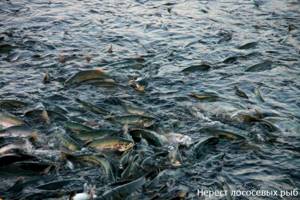
To reproduce, fish most often go to spawn in those streams where they themselves were born. How she finds the route to get to her birthplace remains a mystery to scientists. Spawning occurs in fast rivers with cool water and rocky bottom. The places where salmon lay their eggs have low water levels.
We invite you to familiarize yourself with Metal tiles or corrugated sheets: which is better for a roof, corrugated sheets for roofing, what is the difference, what is different, what is cheaper than a metal profile
The most suitable for breeding are streams with rapids, where there is a current of medium strength and the water is enriched with oxygen. The female chooses a section of the bottom that is relatively safe in her opinion, clears it of debris and digs holes with her tail into which she lays eggs. The male fertilizes the clutch. The pebbles in the laying areas should be small so that the fish can move them with their tail.
During spawning, salmon completely stops feeding and lives only off the fat reserves that it managed to accumulate during its life in the ocean. A starvation diet weakens the fish, so salmon often become easy prey for birds, animals and even humans. By the time the salmon spawning is over and the eggs are already in the ground, the salmon enter the river.
Signs of pink salmon with caviar
This red fish is usually caught at the moments when it either just begins or has already finished spawning. This means that almost any female carcass contains caviar. It is easy to distinguish such a fish from a male: it has not a dark, but a nondescript gray color, its shape is smoother, and its head is less pointed.
In general terms, the female does not look so predatory, but rather smooth and graceful. The presence of caviar is often indicated by the pink color of its belly. During spawning, the male is noticeably transformed in appearance: the carcass and jaw are strongly bent.
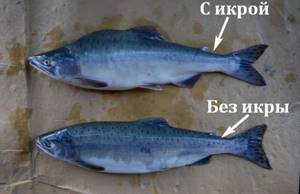
How fry appear and survive
Red fish eggs mature slowly. Only after a month does the shell of the eggs of the fry break open, breaking out. Sometimes the process of ripening caviar is delayed for a longer period. The females guard the clutch all this time. After hatching, the fry begin to feed in the river and live in it for 2 years. Only then do they leave their location and head out to sea. At first, the fry eat microscopic algae, then move on to beetle larvae. In summer, they deftly catch insects from the surface of the water.
When does spawning end and what happens to the fish after it?
The vast majority of male pink salmon simply die after spawning due to changes in their body. External transformations are only the result of a sharp decrease in the amount of fat in the muscles, which leads to sagging meat. The gastrointestinal tract shrinks, and enzymes for the proper functioning of digestion cease to be produced.
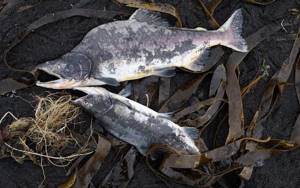
The combination of these factors leads to the inevitable death of spawning fish. After spawning, eggs remain in the bottom soil, and the females return to salty waters: they will be able to mate with other males after 2 years, and if they are lucky, more than once.
What do Atlantic salmon eat?
The main part of salmon is represented by the migratory form, which is born and spends the first 1-5 years of life in a fresh environment. Here it feeds on zooplankton, larvae, worms, insects, crustaceans, mollusks and fry. If the environment is climatically comfortable and sufficiently nourishing for rapid growth, the fish can leave the river already in the second year of life. In cold conditions and when there is a shortage of food, the maturation of young animals to move to the ocean can take up to 6-8 years. It is this circumstance that is the main reason for the formation of the dwarf form of males, which remain forever in the rivers.
To learn more:
Smelt: description of a fish from the smelt family
Having reached a safe size of 20-30 cm, salmon gather in large schools and begin their feeding migration to the sea. Here the fish lead an exclusively predatory lifestyle, hunting sprat, capelin, herring, smelt, and sand lance. The largest accumulation of small ichthyofauna is typical for zooplankton-rich sea waters near Canada and Greenland. This is where the salmon goes to feed, which usually lasts 1-4 years.
Legislative prohibitions on fish spawning
Legislation on fishing in the Russian Federation is regional in nature. For example, on Sakhalin in some parts of the rivers you can catch pink salmon using nets on a paid basis: the payment depends on the volume of the catch. But in most areas of the island, fishing is strictly prohibited by law. First of all, fishing is not allowed within nature reserves, or near structures such as bridges or dams.
Important! Maps are specially compiled for fishermen, which indicate where they cannot catch fish. They can be found publicly available on the Internet.
According to the legislation of Siberia and the Far Eastern District, salmon fishing is possible using fishing rods with a pre-agreed number of hooks and nets. For such fishing, you must obtain a license and assign a unique number to your fishing equipment.

Thus, pink salmon is a commercial fish with a unique life cycle. Its quantity in fresh water bodies fluctuates every year. Spawning is often accompanied by the subsequent death of individuals, which is why in some sections of rivers fishermen have the opportunity to catch a lot of seafood.
The value of salmon caviar
Large bright eggs of rich orange color have a large supply of nutrients. Some species of fish even specifically hunt for salmon eggs. Eggs contain a large amount of protein, valuable fats, healthy acids and microelements. Due to this composition and high calorie content, this product is recommended for increasing immunity and restoring the vitality of people weakened by illness.
We suggest you read How to remove a tree without uprooting
It is recommended for healthy people to consume salmon caviar on an ongoing basis. This product is a familiar delicacy to many. But a single intake of salmon caviar should not exceed 5 tsp.
How to catch salmon
Due to the peculiarities of the growth of young animals and the maturation of reproductive products in individuals preparing for spawning, the species is present in rivers throughout the entire calendar year. But due to innate caution and a developed instinct of self-preservation, it rarely approaches the shore, so the main gear for catching salmon is a long-range spinning rod.
Experienced fishermen recommend using a heavy-class rod 2.7-3.5 m long with a fast or medium action and a top cast of 35-50 g. A power spinning reel with a sensitive drag is selected to match the blank. A braided cord of 0.22-0.25 mm is used as the main fishing line. Oscillating spoons of yellow, red and copper shades, weighing 25-40 g, are considered a universal bait. “Castmaster” is effective when catching salmon, which ensures casting range and high accuracy.
To learn more:
Taimen: a valuable fish of the salmon family
Usually salmon grabs the bait instinctively, seeing it as a threat to their eggs and fry. The main goal of the attack is not to swallow, but to drive away the stranger, so a sharp hook must be made immediately after hitting the spoon. Salmon is a very strong and tireless fish. To avoid the risk of derailment, during the fishing process it is necessary to constantly keep the line in tension, not allowing the prey to rest.

